Mental Health Website Project Grant Application - WA
VerifiedAdded on 2023/06/03
|14
|3660
|58
Project
AI Summary
This grant application outlines a project to develop a mental health website for Afghan men in Perch, Western Australia, addressing the high prevalence of mental health issues within this community. The project aims to create a website in both English and Afghan languages (Pashto, Dari, Uzbek) providing information on mental health causes, symptoms, and treatment options, along with contact information for assistance. The objectives include website development, increasing website access through various media channels, and establishing social media links. The project's strategies involve stakeholder engagement, qualified personnel (web designer, translators), content development, and media promotion. The budget covers website development, translation, print media, and project coordination. The project's success will be evaluated based on timely implementation, community feedback, and a final written report, with key stakeholders including the Afghan-Australian Association and the Islamic Society of Western Australia. The project aligns with health promotion principles and aims to improve the well-being of Afghan men by providing accessible mental health resources.
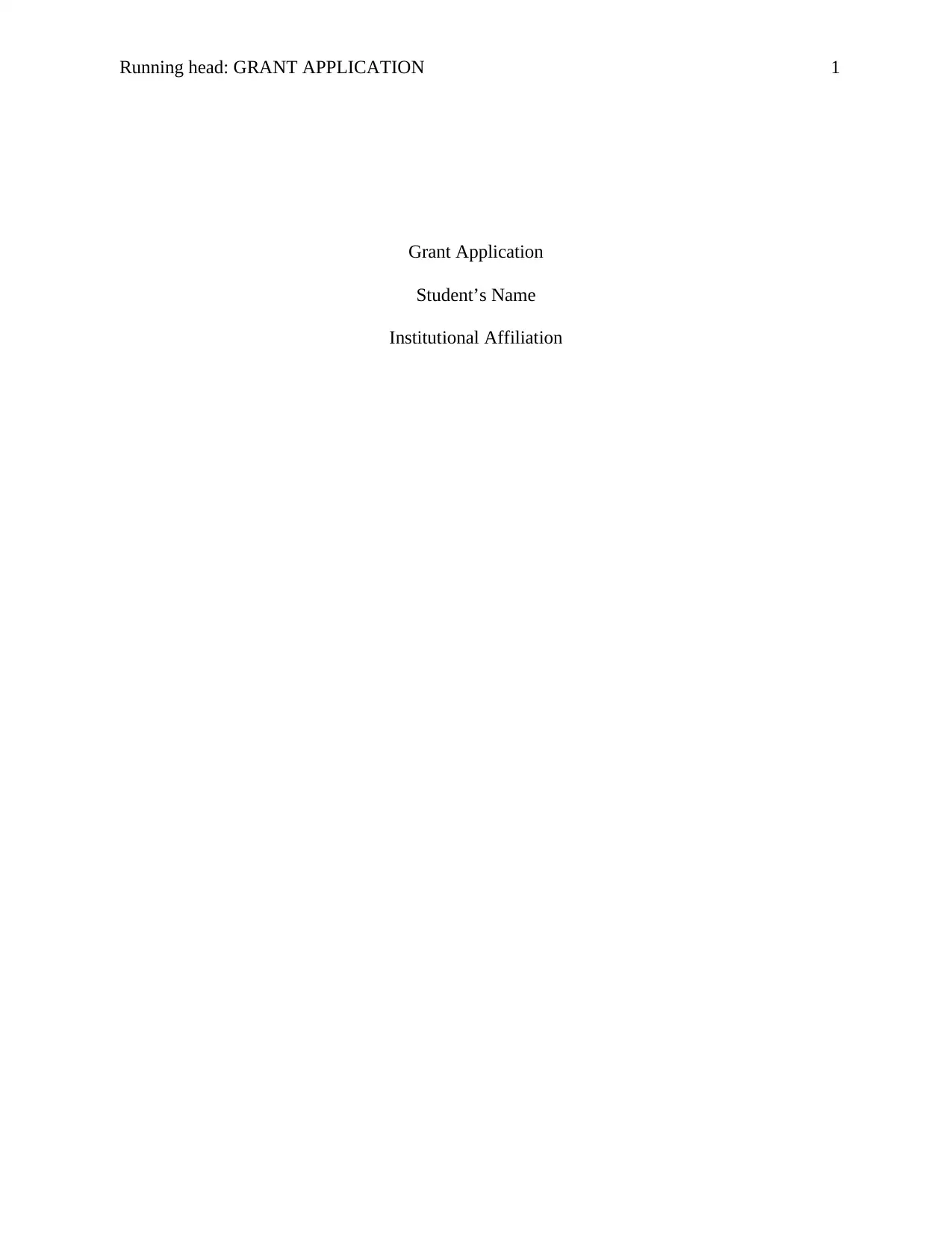
Running head: GRANT APPLICATION 1
Grant Application
Student’s Name
Institutional Affiliation
Grant Application
Student’s Name
Institutional Affiliation
Paraphrase This Document
Need a fresh take? Get an instant paraphrase of this document with our AI Paraphraser
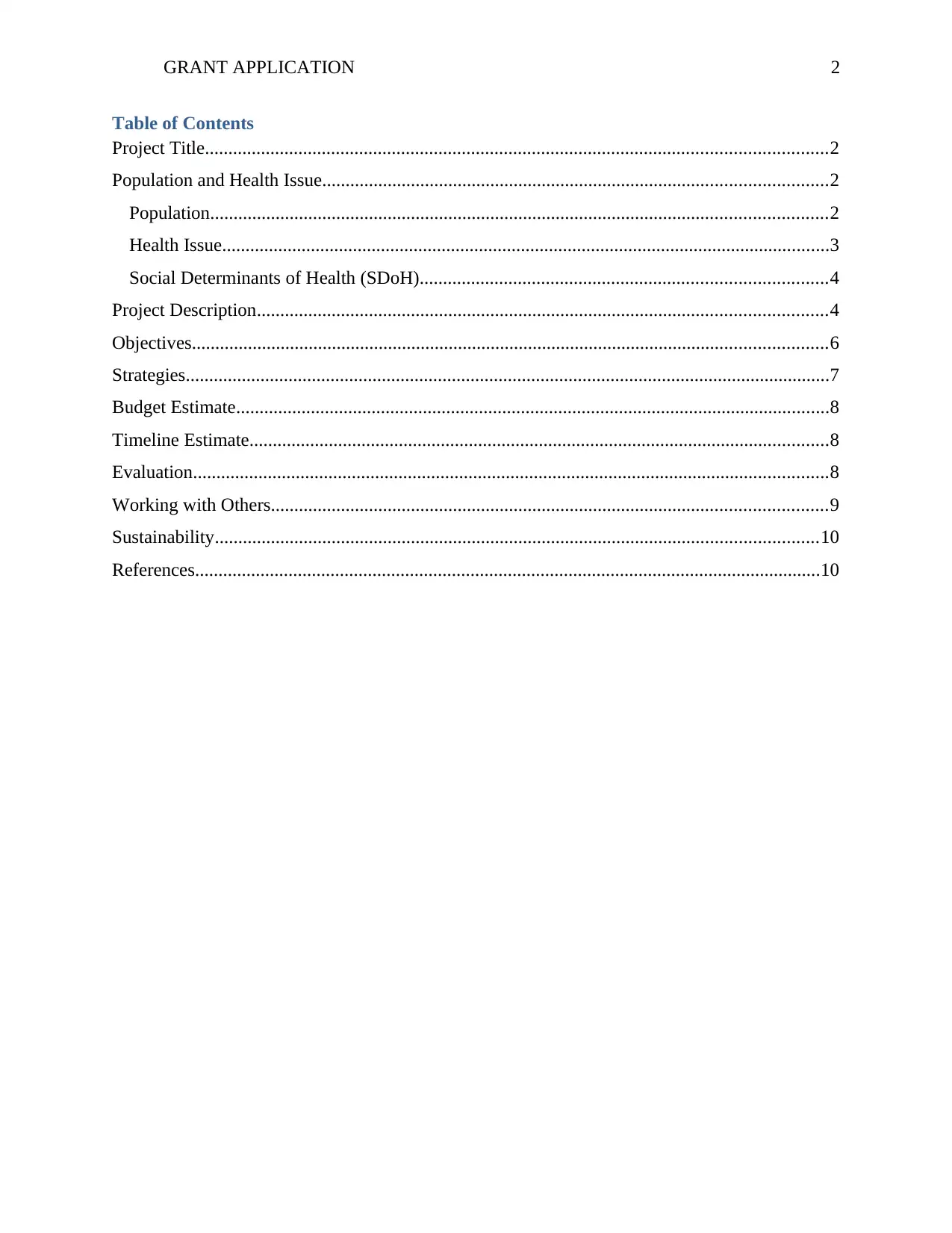
GRANT APPLICATION 2
Table of Contents
Project Title.....................................................................................................................................2
Population and Health Issue............................................................................................................2
Population....................................................................................................................................2
Health Issue..................................................................................................................................3
Social Determinants of Health (SDoH).......................................................................................4
Project Description..........................................................................................................................4
Objectives........................................................................................................................................6
Strategies..........................................................................................................................................7
Budget Estimate...............................................................................................................................8
Timeline Estimate............................................................................................................................8
Evaluation........................................................................................................................................8
Working with Others.......................................................................................................................9
Sustainability.................................................................................................................................10
References......................................................................................................................................10
Table of Contents
Project Title.....................................................................................................................................2
Population and Health Issue............................................................................................................2
Population....................................................................................................................................2
Health Issue..................................................................................................................................3
Social Determinants of Health (SDoH).......................................................................................4
Project Description..........................................................................................................................4
Objectives........................................................................................................................................6
Strategies..........................................................................................................................................7
Budget Estimate...............................................................................................................................8
Timeline Estimate............................................................................................................................8
Evaluation........................................................................................................................................8
Working with Others.......................................................................................................................9
Sustainability.................................................................................................................................10
References......................................................................................................................................10

GRANT APPLICATION 3
Project Title
Mental Health Website Project for Afghan Men Living in Perch, Western Australia (WA)
Population and Health Issue
Population
The W. Australian population has been increasing since 2011 due to the influx of
immigrants like the Afghan people. Recent statistics indicate that 31% of the WA population is
individuals from overseas (ABS, 2016). Approximately 28597 individuals of the people are of
Afghanistan origin. The number of males outnumbers that of females at 58.9% and 41.1%
respectively (AIC, 2012). A majority of the Afghan population speak Dari, Hazari, and Persian
languages. Apart from the three languages, the immigrants also talk the Pashto dialect.
Additionally, 64.6% of the immigrants can speak English while the remaining 28.1% cannot
speak about the language (Blake, Bennetts Kneebone, & McLeod, 2017).
Recent research has shown that a majority of the Afghan immigrants speak in Hazaragi
language since they are Hazaras (Tudsri, & Hebbani, 2015). However, the population speaks in
Dari language when undertaking their socio-economic activities. A majority of the Afghan
community in WA go to mosques to worship as they are Islamic believers. On average, an
ordinary Afghan receives an income which is above $ 272. The immigrants indicate that there
are few employment opportunities in the Western side of Australia (Correa‐Velez, Barnett, &
Gifford, 2015). Additionally, the Afghan people lack the required qualifications for various jobs
in the country. The 2011 census report indicated that less than 40% of the immigrants had
elementary school education (AGDIC, 2012). 41% of the population is employed in the formal
sector while 18.5 % lack the necessary skills to access job opportunities (Correa‐Velez, Barnett,
& Gifford, 2015). A recent study has also shown that most Afghan men are farmers.
Project Title
Mental Health Website Project for Afghan Men Living in Perch, Western Australia (WA)
Population and Health Issue
Population
The W. Australian population has been increasing since 2011 due to the influx of
immigrants like the Afghan people. Recent statistics indicate that 31% of the WA population is
individuals from overseas (ABS, 2016). Approximately 28597 individuals of the people are of
Afghanistan origin. The number of males outnumbers that of females at 58.9% and 41.1%
respectively (AIC, 2012). A majority of the Afghan population speak Dari, Hazari, and Persian
languages. Apart from the three languages, the immigrants also talk the Pashto dialect.
Additionally, 64.6% of the immigrants can speak English while the remaining 28.1% cannot
speak about the language (Blake, Bennetts Kneebone, & McLeod, 2017).
Recent research has shown that a majority of the Afghan immigrants speak in Hazaragi
language since they are Hazaras (Tudsri, & Hebbani, 2015). However, the population speaks in
Dari language when undertaking their socio-economic activities. A majority of the Afghan
community in WA go to mosques to worship as they are Islamic believers. On average, an
ordinary Afghan receives an income which is above $ 272. The immigrants indicate that there
are few employment opportunities in the Western side of Australia (Correa‐Velez, Barnett, &
Gifford, 2015). Additionally, the Afghan people lack the required qualifications for various jobs
in the country. The 2011 census report indicated that less than 40% of the immigrants had
elementary school education (AGDIC, 2012). 41% of the population is employed in the formal
sector while 18.5 % lack the necessary skills to access job opportunities (Correa‐Velez, Barnett,
& Gifford, 2015). A recent study has also shown that most Afghan men are farmers.
⊘ This is a preview!⊘
Do you want full access?
Subscribe today to unlock all pages.

Trusted by 1+ million students worldwide
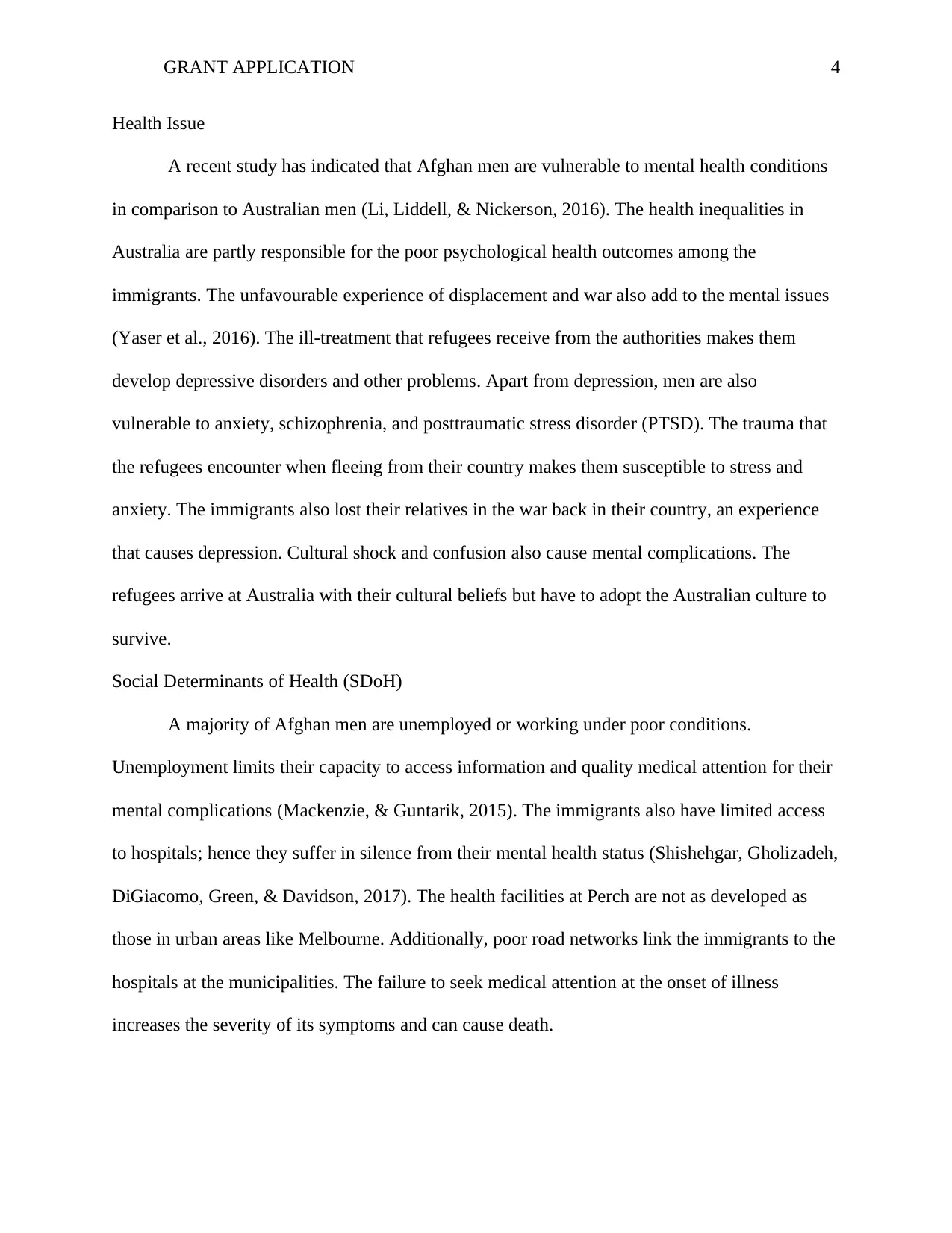
GRANT APPLICATION 4
Health Issue
A recent study has indicated that Afghan men are vulnerable to mental health conditions
in comparison to Australian men (Li, Liddell, & Nickerson, 2016). The health inequalities in
Australia are partly responsible for the poor psychological health outcomes among the
immigrants. The unfavourable experience of displacement and war also add to the mental issues
(Yaser et al., 2016). The ill-treatment that refugees receive from the authorities makes them
develop depressive disorders and other problems. Apart from depression, men are also
vulnerable to anxiety, schizophrenia, and posttraumatic stress disorder (PTSD). The trauma that
the refugees encounter when fleeing from their country makes them susceptible to stress and
anxiety. The immigrants also lost their relatives in the war back in their country, an experience
that causes depression. Cultural shock and confusion also cause mental complications. The
refugees arrive at Australia with their cultural beliefs but have to adopt the Australian culture to
survive.
Social Determinants of Health (SDoH)
A majority of Afghan men are unemployed or working under poor conditions.
Unemployment limits their capacity to access information and quality medical attention for their
mental complications (Mackenzie, & Guntarik, 2015). The immigrants also have limited access
to hospitals; hence they suffer in silence from their mental health status (Shishehgar, Gholizadeh,
DiGiacomo, Green, & Davidson, 2017). The health facilities at Perch are not as developed as
those in urban areas like Melbourne. Additionally, poor road networks link the immigrants to the
hospitals at the municipalities. The failure to seek medical attention at the onset of illness
increases the severity of its symptoms and can cause death.
Health Issue
A recent study has indicated that Afghan men are vulnerable to mental health conditions
in comparison to Australian men (Li, Liddell, & Nickerson, 2016). The health inequalities in
Australia are partly responsible for the poor psychological health outcomes among the
immigrants. The unfavourable experience of displacement and war also add to the mental issues
(Yaser et al., 2016). The ill-treatment that refugees receive from the authorities makes them
develop depressive disorders and other problems. Apart from depression, men are also
vulnerable to anxiety, schizophrenia, and posttraumatic stress disorder (PTSD). The trauma that
the refugees encounter when fleeing from their country makes them susceptible to stress and
anxiety. The immigrants also lost their relatives in the war back in their country, an experience
that causes depression. Cultural shock and confusion also cause mental complications. The
refugees arrive at Australia with their cultural beliefs but have to adopt the Australian culture to
survive.
Social Determinants of Health (SDoH)
A majority of Afghan men are unemployed or working under poor conditions.
Unemployment limits their capacity to access information and quality medical attention for their
mental complications (Mackenzie, & Guntarik, 2015). The immigrants also have limited access
to hospitals; hence they suffer in silence from their mental health status (Shishehgar, Gholizadeh,
DiGiacomo, Green, & Davidson, 2017). The health facilities at Perch are not as developed as
those in urban areas like Melbourne. Additionally, poor road networks link the immigrants to the
hospitals at the municipalities. The failure to seek medical attention at the onset of illness
increases the severity of its symptoms and can cause death.
Paraphrase This Document
Need a fresh take? Get an instant paraphrase of this document with our AI Paraphraser
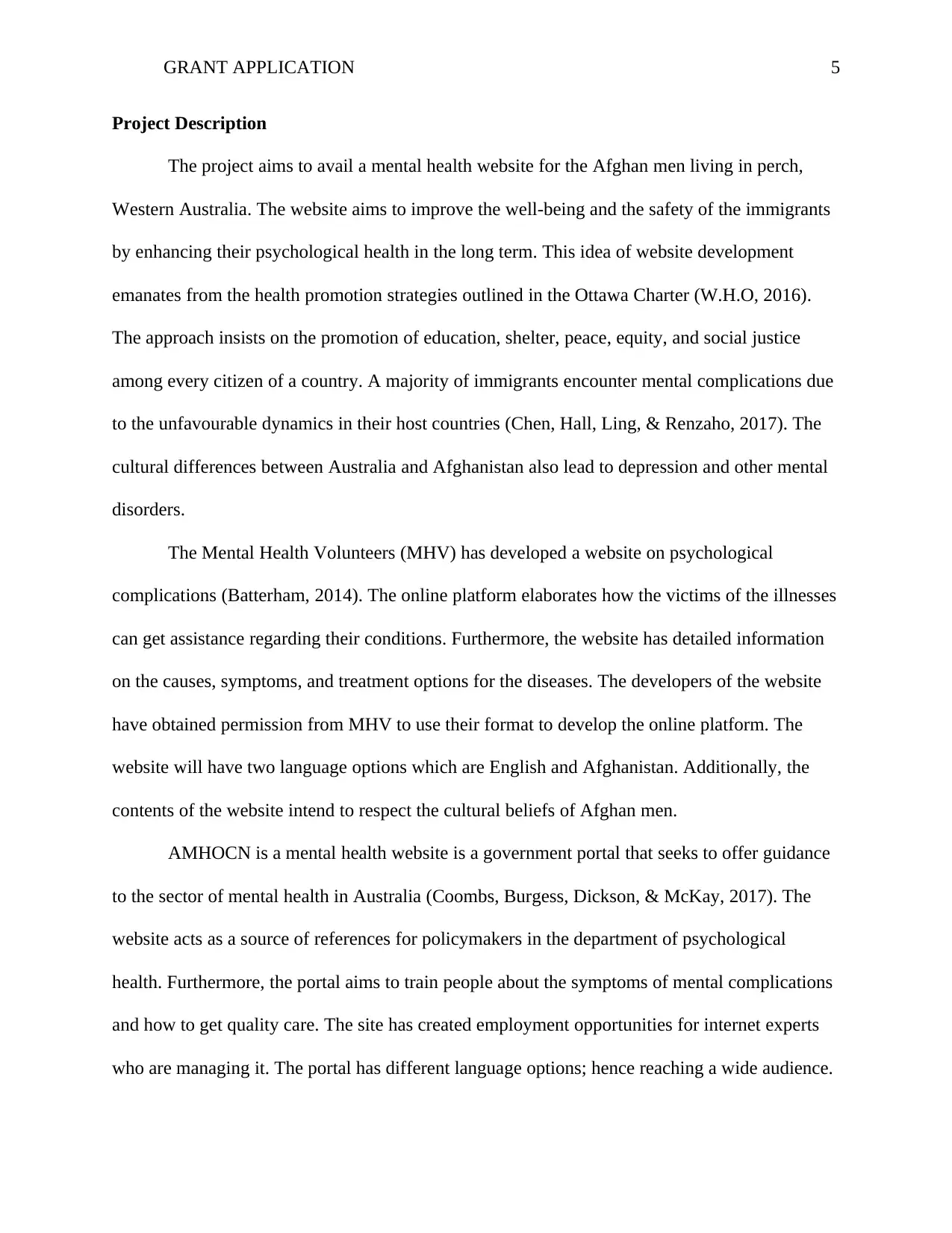
GRANT APPLICATION 5
Project Description
The project aims to avail a mental health website for the Afghan men living in perch,
Western Australia. The website aims to improve the well-being and the safety of the immigrants
by enhancing their psychological health in the long term. This idea of website development
emanates from the health promotion strategies outlined in the Ottawa Charter (W.H.O, 2016).
The approach insists on the promotion of education, shelter, peace, equity, and social justice
among every citizen of a country. A majority of immigrants encounter mental complications due
to the unfavourable dynamics in their host countries (Chen, Hall, Ling, & Renzaho, 2017). The
cultural differences between Australia and Afghanistan also lead to depression and other mental
disorders.
The Mental Health Volunteers (MHV) has developed a website on psychological
complications (Batterham, 2014). The online platform elaborates how the victims of the illnesses
can get assistance regarding their conditions. Furthermore, the website has detailed information
on the causes, symptoms, and treatment options for the diseases. The developers of the website
have obtained permission from MHV to use their format to develop the online platform. The
website will have two language options which are English and Afghanistan. Additionally, the
contents of the website intend to respect the cultural beliefs of Afghan men.
AMHOCN is a mental health website is a government portal that seeks to offer guidance
to the sector of mental health in Australia (Coombs, Burgess, Dickson, & McKay, 2017). The
website acts as a source of references for policymakers in the department of psychological
health. Furthermore, the portal aims to train people about the symptoms of mental complications
and how to get quality care. The site has created employment opportunities for internet experts
who are managing it. The portal has different language options; hence reaching a wide audience.
Project Description
The project aims to avail a mental health website for the Afghan men living in perch,
Western Australia. The website aims to improve the well-being and the safety of the immigrants
by enhancing their psychological health in the long term. This idea of website development
emanates from the health promotion strategies outlined in the Ottawa Charter (W.H.O, 2016).
The approach insists on the promotion of education, shelter, peace, equity, and social justice
among every citizen of a country. A majority of immigrants encounter mental complications due
to the unfavourable dynamics in their host countries (Chen, Hall, Ling, & Renzaho, 2017). The
cultural differences between Australia and Afghanistan also lead to depression and other mental
disorders.
The Mental Health Volunteers (MHV) has developed a website on psychological
complications (Batterham, 2014). The online platform elaborates how the victims of the illnesses
can get assistance regarding their conditions. Furthermore, the website has detailed information
on the causes, symptoms, and treatment options for the diseases. The developers of the website
have obtained permission from MHV to use their format to develop the online platform. The
website will have two language options which are English and Afghanistan. Additionally, the
contents of the website intend to respect the cultural beliefs of Afghan men.
AMHOCN is a mental health website is a government portal that seeks to offer guidance
to the sector of mental health in Australia (Coombs, Burgess, Dickson, & McKay, 2017). The
website acts as a source of references for policymakers in the department of psychological
health. Furthermore, the portal aims to train people about the symptoms of mental complications
and how to get quality care. The site has created employment opportunities for internet experts
who are managing it. The portal has different language options; hence reaching a wide audience.
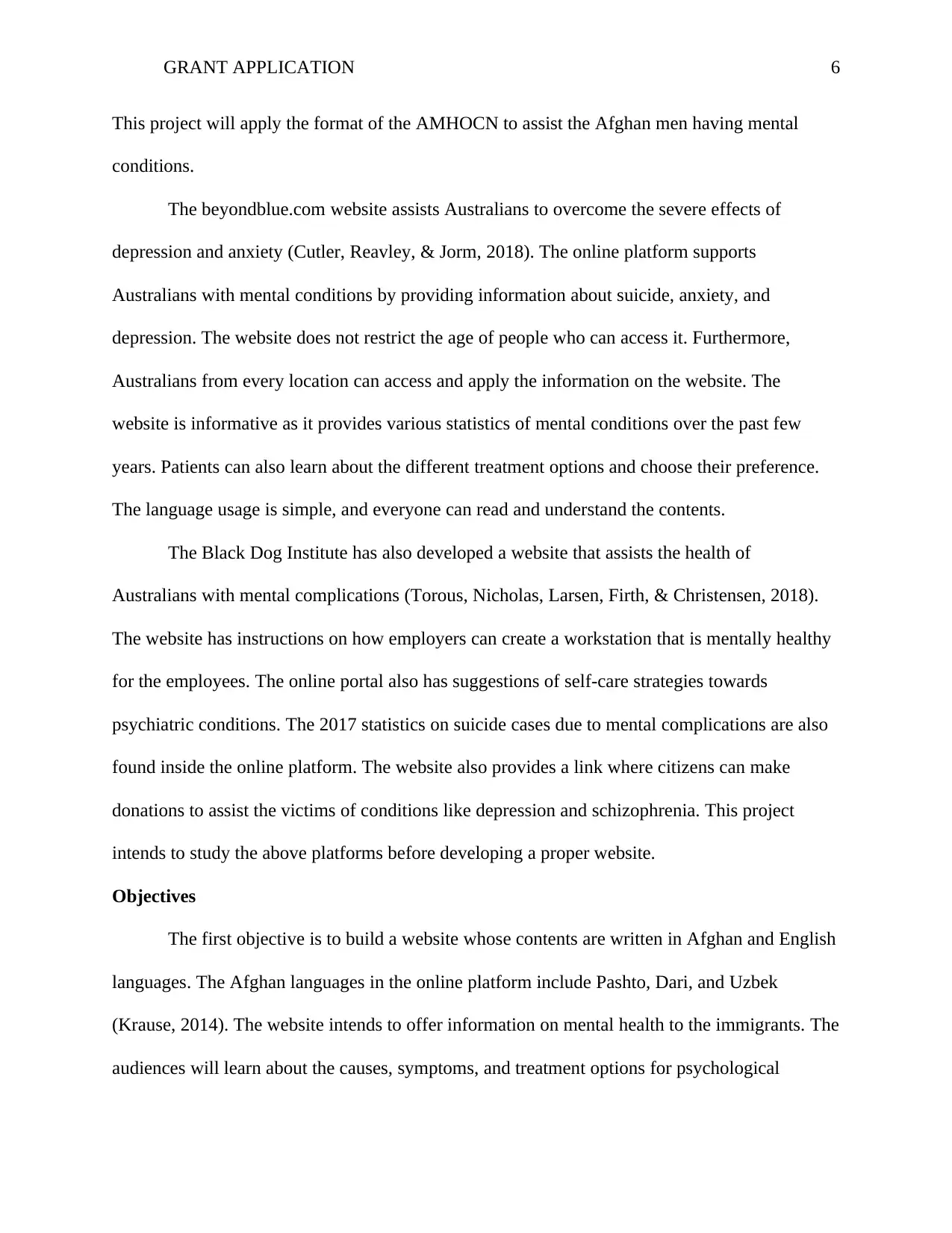
GRANT APPLICATION 6
This project will apply the format of the AMHOCN to assist the Afghan men having mental
conditions.
The beyondblue.com website assists Australians to overcome the severe effects of
depression and anxiety (Cutler, Reavley, & Jorm, 2018). The online platform supports
Australians with mental conditions by providing information about suicide, anxiety, and
depression. The website does not restrict the age of people who can access it. Furthermore,
Australians from every location can access and apply the information on the website. The
website is informative as it provides various statistics of mental conditions over the past few
years. Patients can also learn about the different treatment options and choose their preference.
The language usage is simple, and everyone can read and understand the contents.
The Black Dog Institute has also developed a website that assists the health of
Australians with mental complications (Torous, Nicholas, Larsen, Firth, & Christensen, 2018).
The website has instructions on how employers can create a workstation that is mentally healthy
for the employees. The online portal also has suggestions of self-care strategies towards
psychiatric conditions. The 2017 statistics on suicide cases due to mental complications are also
found inside the online platform. The website also provides a link where citizens can make
donations to assist the victims of conditions like depression and schizophrenia. This project
intends to study the above platforms before developing a proper website.
Objectives
The first objective is to build a website whose contents are written in Afghan and English
languages. The Afghan languages in the online platform include Pashto, Dari, and Uzbek
(Krause, 2014). The website intends to offer information on mental health to the immigrants. The
audiences will learn about the causes, symptoms, and treatment options for psychological
This project will apply the format of the AMHOCN to assist the Afghan men having mental
conditions.
The beyondblue.com website assists Australians to overcome the severe effects of
depression and anxiety (Cutler, Reavley, & Jorm, 2018). The online platform supports
Australians with mental conditions by providing information about suicide, anxiety, and
depression. The website does not restrict the age of people who can access it. Furthermore,
Australians from every location can access and apply the information on the website. The
website is informative as it provides various statistics of mental conditions over the past few
years. Patients can also learn about the different treatment options and choose their preference.
The language usage is simple, and everyone can read and understand the contents.
The Black Dog Institute has also developed a website that assists the health of
Australians with mental complications (Torous, Nicholas, Larsen, Firth, & Christensen, 2018).
The website has instructions on how employers can create a workstation that is mentally healthy
for the employees. The online portal also has suggestions of self-care strategies towards
psychiatric conditions. The 2017 statistics on suicide cases due to mental complications are also
found inside the online platform. The website also provides a link where citizens can make
donations to assist the victims of conditions like depression and schizophrenia. This project
intends to study the above platforms before developing a proper website.
Objectives
The first objective is to build a website whose contents are written in Afghan and English
languages. The Afghan languages in the online platform include Pashto, Dari, and Uzbek
(Krause, 2014). The website intends to offer information on mental health to the immigrants. The
audiences will learn about the causes, symptoms, and treatment options for psychological
⊘ This is a preview!⊘
Do you want full access?
Subscribe today to unlock all pages.

Trusted by 1+ million students worldwide

GRANT APPLICATION 7
complications. The portal will also contain telephone contacts which the victims can call for
assistance. The statistics on the mental health patients will also be inclusive in the platform. The
developers want to ensure that the website is operational after one month. The first dispensation
will contain ten pages having three hundred words per page. The languages used are English and
the Afghan languages like Pashto, Dari, Uzbek, and Balochi.
The second aim is to increase the access by the Afghan men in Australia to the mental
health website. The stakeholders will reach a wide audience by advertising the platform's details
in the local television and newspapers. Postures will also be available at the local billboards to
alert the residents of the existence of the website. The developers will allow the postures to stay
the billboards for one month. The stakeholders will also print handouts and distribute them to the
local Afghan community in Western Australia. The developers will also place advertisements on
local radio stations to reach individuals who do not possess television sets. The stakeholders will
also urge the local leaders like religious heads to inform residents about the website.
Strategies
Find out the identity of the stakeholders, and develop a relationship with the Afghan
community. Inform the residents about the existence of the project and the timelines of launching
and implementing the contents of the website. Maintain a healthy relationship with the Afghan
people.
Obtain qualified web designer and well-versed language translators. The web designer
should develop a platform that the Afghan men and women can access with ease. The translators
should be versed with the various Afghan languages and the English language (Baker, 2016).
complications. The portal will also contain telephone contacts which the victims can call for
assistance. The statistics on the mental health patients will also be inclusive in the platform. The
developers want to ensure that the website is operational after one month. The first dispensation
will contain ten pages having three hundred words per page. The languages used are English and
the Afghan languages like Pashto, Dari, Uzbek, and Balochi.
The second aim is to increase the access by the Afghan men in Australia to the mental
health website. The stakeholders will reach a wide audience by advertising the platform's details
in the local television and newspapers. Postures will also be available at the local billboards to
alert the residents of the existence of the website. The developers will allow the postures to stay
the billboards for one month. The stakeholders will also print handouts and distribute them to the
local Afghan community in Western Australia. The developers will also place advertisements on
local radio stations to reach individuals who do not possess television sets. The stakeholders will
also urge the local leaders like religious heads to inform residents about the website.
Strategies
Find out the identity of the stakeholders, and develop a relationship with the Afghan
community. Inform the residents about the existence of the project and the timelines of launching
and implementing the contents of the website. Maintain a healthy relationship with the Afghan
people.
Obtain qualified web designer and well-versed language translators. The web designer
should develop a platform that the Afghan men and women can access with ease. The translators
should be versed with the various Afghan languages and the English language (Baker, 2016).
Paraphrase This Document
Need a fresh take? Get an instant paraphrase of this document with our AI Paraphraser
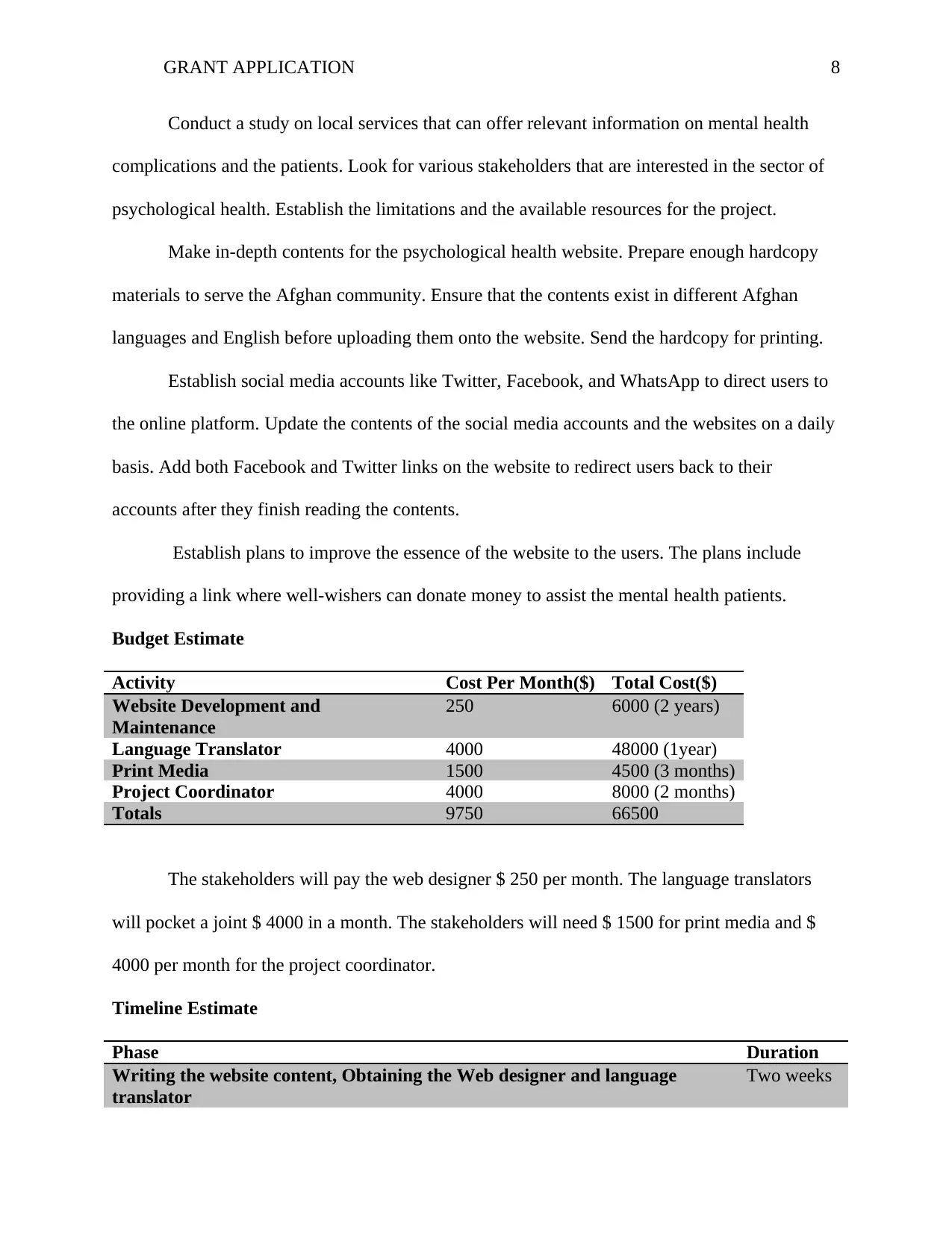
GRANT APPLICATION 8
Conduct a study on local services that can offer relevant information on mental health
complications and the patients. Look for various stakeholders that are interested in the sector of
psychological health. Establish the limitations and the available resources for the project.
Make in-depth contents for the psychological health website. Prepare enough hardcopy
materials to serve the Afghan community. Ensure that the contents exist in different Afghan
languages and English before uploading them onto the website. Send the hardcopy for printing.
Establish social media accounts like Twitter, Facebook, and WhatsApp to direct users to
the online platform. Update the contents of the social media accounts and the websites on a daily
basis. Add both Facebook and Twitter links on the website to redirect users back to their
accounts after they finish reading the contents.
Establish plans to improve the essence of the website to the users. The plans include
providing a link where well-wishers can donate money to assist the mental health patients.
Budget Estimate
Activity Cost Per Month($) Total Cost($)
Website Development and
Maintenance
250 6000 (2 years)
Language Translator 4000 48000 (1year)
Print Media 1500 4500 (3 months)
Project Coordinator 4000 8000 (2 months)
Totals 9750 66500
The stakeholders will pay the web designer $ 250 per month. The language translators
will pocket a joint $ 4000 in a month. The stakeholders will need $ 1500 for print media and $
4000 per month for the project coordinator.
Timeline Estimate
Phase Duration
Writing the website content, Obtaining the Web designer and language
translator
Two weeks
Conduct a study on local services that can offer relevant information on mental health
complications and the patients. Look for various stakeholders that are interested in the sector of
psychological health. Establish the limitations and the available resources for the project.
Make in-depth contents for the psychological health website. Prepare enough hardcopy
materials to serve the Afghan community. Ensure that the contents exist in different Afghan
languages and English before uploading them onto the website. Send the hardcopy for printing.
Establish social media accounts like Twitter, Facebook, and WhatsApp to direct users to
the online platform. Update the contents of the social media accounts and the websites on a daily
basis. Add both Facebook and Twitter links on the website to redirect users back to their
accounts after they finish reading the contents.
Establish plans to improve the essence of the website to the users. The plans include
providing a link where well-wishers can donate money to assist the mental health patients.
Budget Estimate
Activity Cost Per Month($) Total Cost($)
Website Development and
Maintenance
250 6000 (2 years)
Language Translator 4000 48000 (1year)
Print Media 1500 4500 (3 months)
Project Coordinator 4000 8000 (2 months)
Totals 9750 66500
The stakeholders will pay the web designer $ 250 per month. The language translators
will pocket a joint $ 4000 in a month. The stakeholders will need $ 1500 for print media and $
4000 per month for the project coordinator.
Timeline Estimate
Phase Duration
Writing the website content, Obtaining the Web designer and language
translator
Two weeks
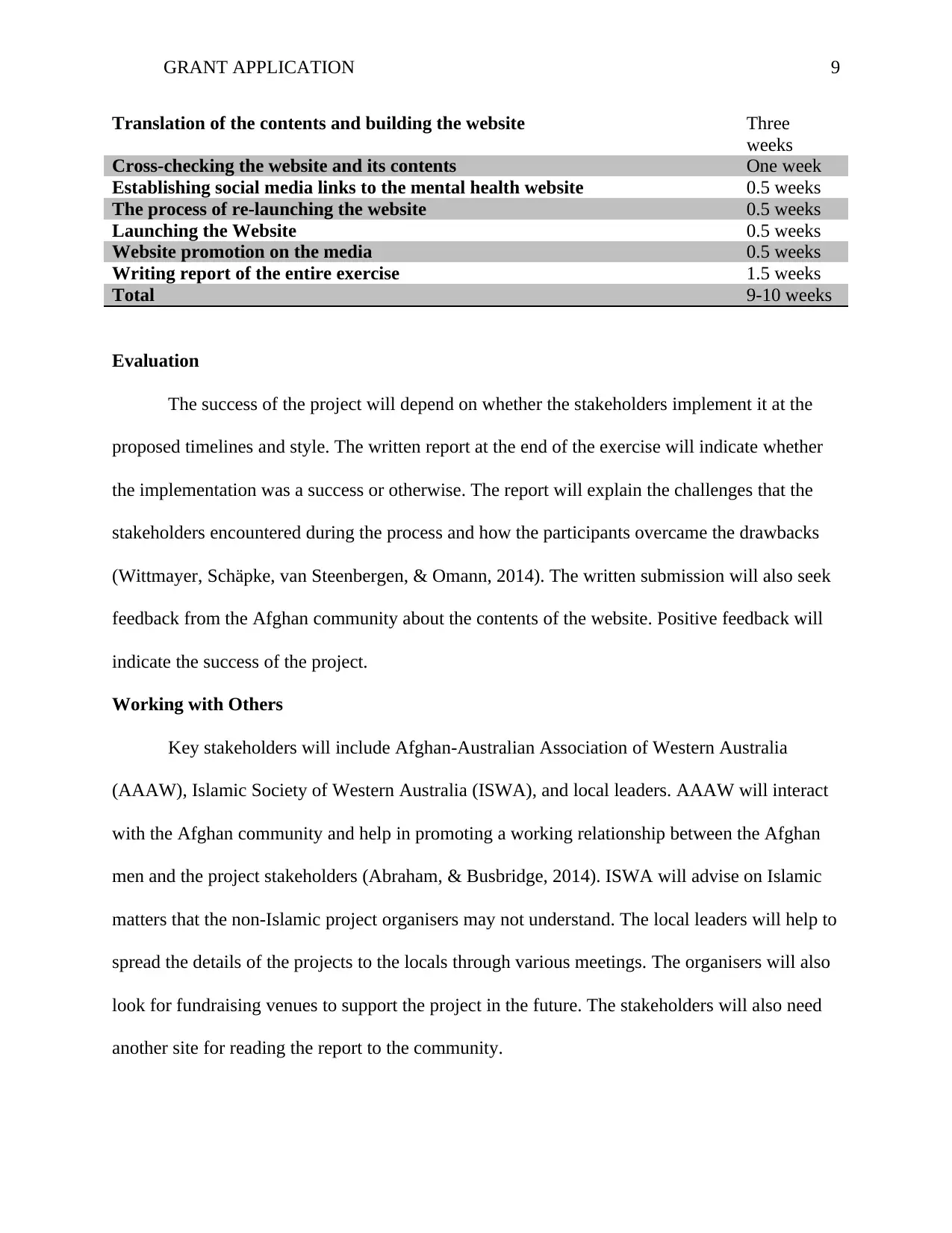
GRANT APPLICATION 9
Translation of the contents and building the website Three
weeks
Cross-checking the website and its contents One week
Establishing social media links to the mental health website 0.5 weeks
The process of re-launching the website 0.5 weeks
Launching the Website 0.5 weeks
Website promotion on the media 0.5 weeks
Writing report of the entire exercise 1.5 weeks
Total 9-10 weeks
Evaluation
The success of the project will depend on whether the stakeholders implement it at the
proposed timelines and style. The written report at the end of the exercise will indicate whether
the implementation was a success or otherwise. The report will explain the challenges that the
stakeholders encountered during the process and how the participants overcame the drawbacks
(Wittmayer, Schäpke, van Steenbergen, & Omann, 2014). The written submission will also seek
feedback from the Afghan community about the contents of the website. Positive feedback will
indicate the success of the project.
Working with Others
Key stakeholders will include Afghan-Australian Association of Western Australia
(AAAW), Islamic Society of Western Australia (ISWA), and local leaders. AAAW will interact
with the Afghan community and help in promoting a working relationship between the Afghan
men and the project stakeholders (Abraham, & Busbridge, 2014). ISWA will advise on Islamic
matters that the non-Islamic project organisers may not understand. The local leaders will help to
spread the details of the projects to the locals through various meetings. The organisers will also
look for fundraising venues to support the project in the future. The stakeholders will also need
another site for reading the report to the community.
Translation of the contents and building the website Three
weeks
Cross-checking the website and its contents One week
Establishing social media links to the mental health website 0.5 weeks
The process of re-launching the website 0.5 weeks
Launching the Website 0.5 weeks
Website promotion on the media 0.5 weeks
Writing report of the entire exercise 1.5 weeks
Total 9-10 weeks
Evaluation
The success of the project will depend on whether the stakeholders implement it at the
proposed timelines and style. The written report at the end of the exercise will indicate whether
the implementation was a success or otherwise. The report will explain the challenges that the
stakeholders encountered during the process and how the participants overcame the drawbacks
(Wittmayer, Schäpke, van Steenbergen, & Omann, 2014). The written submission will also seek
feedback from the Afghan community about the contents of the website. Positive feedback will
indicate the success of the project.
Working with Others
Key stakeholders will include Afghan-Australian Association of Western Australia
(AAAW), Islamic Society of Western Australia (ISWA), and local leaders. AAAW will interact
with the Afghan community and help in promoting a working relationship between the Afghan
men and the project stakeholders (Abraham, & Busbridge, 2014). ISWA will advise on Islamic
matters that the non-Islamic project organisers may not understand. The local leaders will help to
spread the details of the projects to the locals through various meetings. The organisers will also
look for fundraising venues to support the project in the future. The stakeholders will also need
another site for reading the report to the community.
⊘ This is a preview!⊘
Do you want full access?
Subscribe today to unlock all pages.

Trusted by 1+ million students worldwide

GRANT APPLICATION 10
Other stakeholders will include local business people, the Islamic community, and
government representatives. The three groups of stakeholders will either assist to finance the
project or provide valuable advice on during its progress. The media is another important
stakeholder who will advertise the project to the Afghan audience. Local schools will provide
venues for meetings between the Afghan communities and the organisers. Health specialists
from the state mental health department will provide information and statistics on psychological
conditions. Therefore, the success of the project will require a wide range of stakeholders.
Sustainability
The depletion of the initial funds can jeopardise the continuity of the project. Therefore,
fundraising to facilitate the viability of the project is necessary. The organisers can achieve this
by asking the partners mentioned above to assist in funding the project. The organisers also need
to train the Afghan community on how to access and utilise the website. Support activities like
donating smartphones and bundles will enable the community to maximise the information in the
online platform. The organisers should make regular visits to the community to urge the men to
continue using the portal for mental health purposes.
The organisers with the help of the partners should establish a computer resource centre
where people without computers can access the website. Additionally, the government should
build a physical library where the locals can acquire the hard copies. Obtaining both the online
and the physical library should be free for everyone (Choy, & Goh, 2016). The project manager
should maintain the phone contacts of the religious leaders and other local leaders. The regular
communication between the organisers and the leaders can sort out any problems from the
Afghan men and their spouses. Therefore, sufficient funds are necessary for long-term access
and functioning of the website.
Other stakeholders will include local business people, the Islamic community, and
government representatives. The three groups of stakeholders will either assist to finance the
project or provide valuable advice on during its progress. The media is another important
stakeholder who will advertise the project to the Afghan audience. Local schools will provide
venues for meetings between the Afghan communities and the organisers. Health specialists
from the state mental health department will provide information and statistics on psychological
conditions. Therefore, the success of the project will require a wide range of stakeholders.
Sustainability
The depletion of the initial funds can jeopardise the continuity of the project. Therefore,
fundraising to facilitate the viability of the project is necessary. The organisers can achieve this
by asking the partners mentioned above to assist in funding the project. The organisers also need
to train the Afghan community on how to access and utilise the website. Support activities like
donating smartphones and bundles will enable the community to maximise the information in the
online platform. The organisers should make regular visits to the community to urge the men to
continue using the portal for mental health purposes.
The organisers with the help of the partners should establish a computer resource centre
where people without computers can access the website. Additionally, the government should
build a physical library where the locals can acquire the hard copies. Obtaining both the online
and the physical library should be free for everyone (Choy, & Goh, 2016). The project manager
should maintain the phone contacts of the religious leaders and other local leaders. The regular
communication between the organisers and the leaders can sort out any problems from the
Afghan men and their spouses. Therefore, sufficient funds are necessary for long-term access
and functioning of the website.
Paraphrase This Document
Need a fresh take? Get an instant paraphrase of this document with our AI Paraphraser
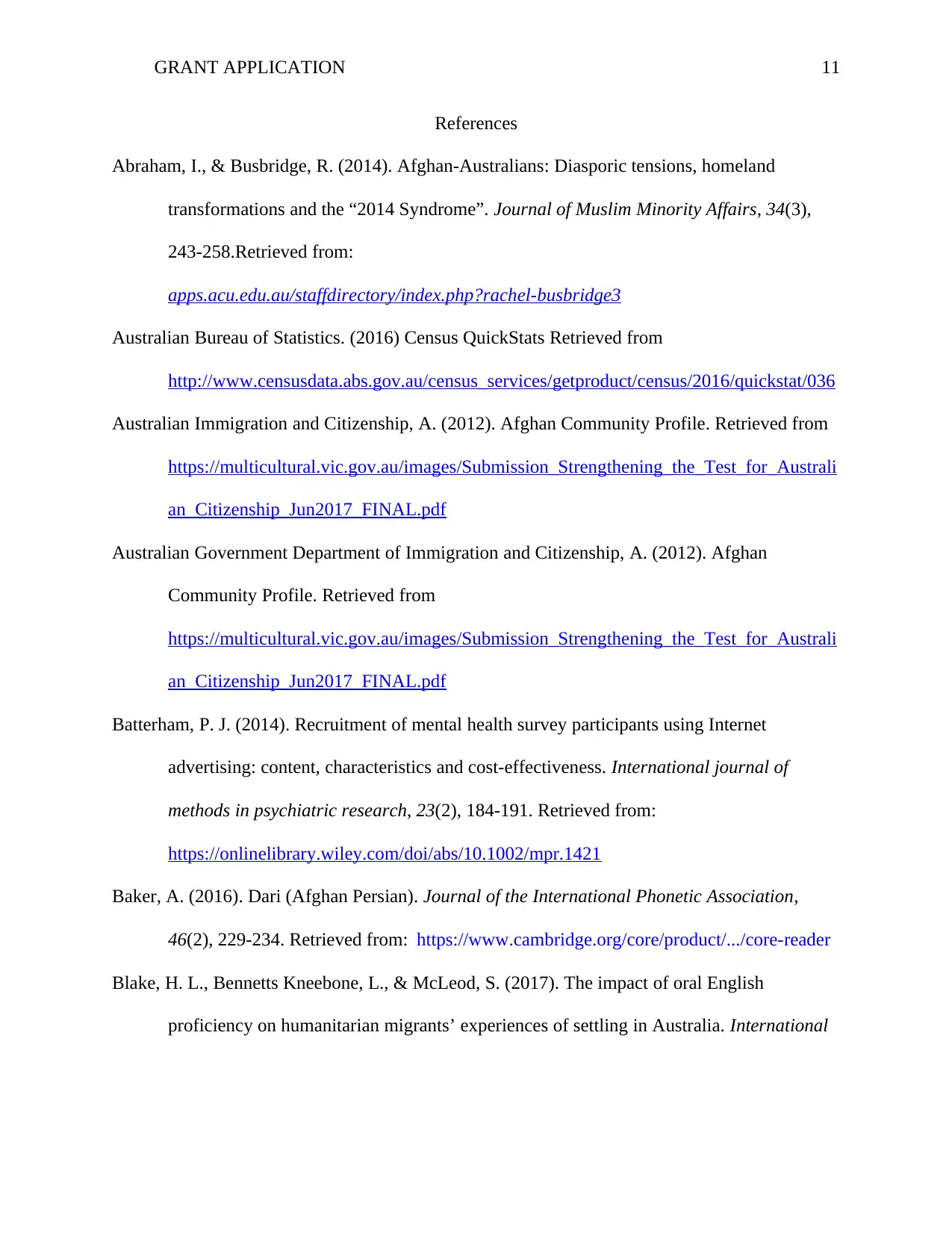
GRANT APPLICATION 11
References
Abraham, I., & Busbridge, R. (2014). Afghan-Australians: Diasporic tensions, homeland
transformations and the “2014 Syndrome”. Journal of Muslim Minority Affairs, 34(3),
243-258.Retrieved from:
apps.acu.edu.au/staffdirectory/index.php?rachel-busbridge3
Australian Bureau of Statistics. (2016) Census QuickStats Retrieved from
http://www.censusdata.abs.gov.au/census_services/getproduct/census/2016/quickstat/036
Australian Immigration and Citizenship, A. (2012). Afghan Community Profile. Retrieved from
https://multicultural.vic.gov.au/images/Submission_Strengthening_the_Test_for_Australi
an_Citizenship_Jun2017_FINAL.pdf
Australian Government Department of Immigration and Citizenship, A. (2012). Afghan
Community Profile. Retrieved from
https://multicultural.vic.gov.au/images/Submission_Strengthening_the_Test_for_Australi
an_Citizenship_Jun2017_FINAL.pdf
Batterham, P. J. (2014). Recruitment of mental health survey participants using Internet
advertising: content, characteristics and cost-effectiveness. International journal of
methods in psychiatric research, 23(2), 184-191. Retrieved from:
https://onlinelibrary.wiley.com/doi/abs/10.1002/mpr.1421
Baker, A. (2016). Dari (Afghan Persian). Journal of the International Phonetic Association,
46(2), 229-234. Retrieved from: https://www.cambridge.org/core/product/.../core-reader
Blake, H. L., Bennetts Kneebone, L., & McLeod, S. (2017). The impact of oral English
proficiency on humanitarian migrants’ experiences of settling in Australia. International
References
Abraham, I., & Busbridge, R. (2014). Afghan-Australians: Diasporic tensions, homeland
transformations and the “2014 Syndrome”. Journal of Muslim Minority Affairs, 34(3),
243-258.Retrieved from:
apps.acu.edu.au/staffdirectory/index.php?rachel-busbridge3
Australian Bureau of Statistics. (2016) Census QuickStats Retrieved from
http://www.censusdata.abs.gov.au/census_services/getproduct/census/2016/quickstat/036
Australian Immigration and Citizenship, A. (2012). Afghan Community Profile. Retrieved from
https://multicultural.vic.gov.au/images/Submission_Strengthening_the_Test_for_Australi
an_Citizenship_Jun2017_FINAL.pdf
Australian Government Department of Immigration and Citizenship, A. (2012). Afghan
Community Profile. Retrieved from
https://multicultural.vic.gov.au/images/Submission_Strengthening_the_Test_for_Australi
an_Citizenship_Jun2017_FINAL.pdf
Batterham, P. J. (2014). Recruitment of mental health survey participants using Internet
advertising: content, characteristics and cost-effectiveness. International journal of
methods in psychiatric research, 23(2), 184-191. Retrieved from:
https://onlinelibrary.wiley.com/doi/abs/10.1002/mpr.1421
Baker, A. (2016). Dari (Afghan Persian). Journal of the International Phonetic Association,
46(2), 229-234. Retrieved from: https://www.cambridge.org/core/product/.../core-reader
Blake, H. L., Bennetts Kneebone, L., & McLeod, S. (2017). The impact of oral English
proficiency on humanitarian migrants’ experiences of settling in Australia. International
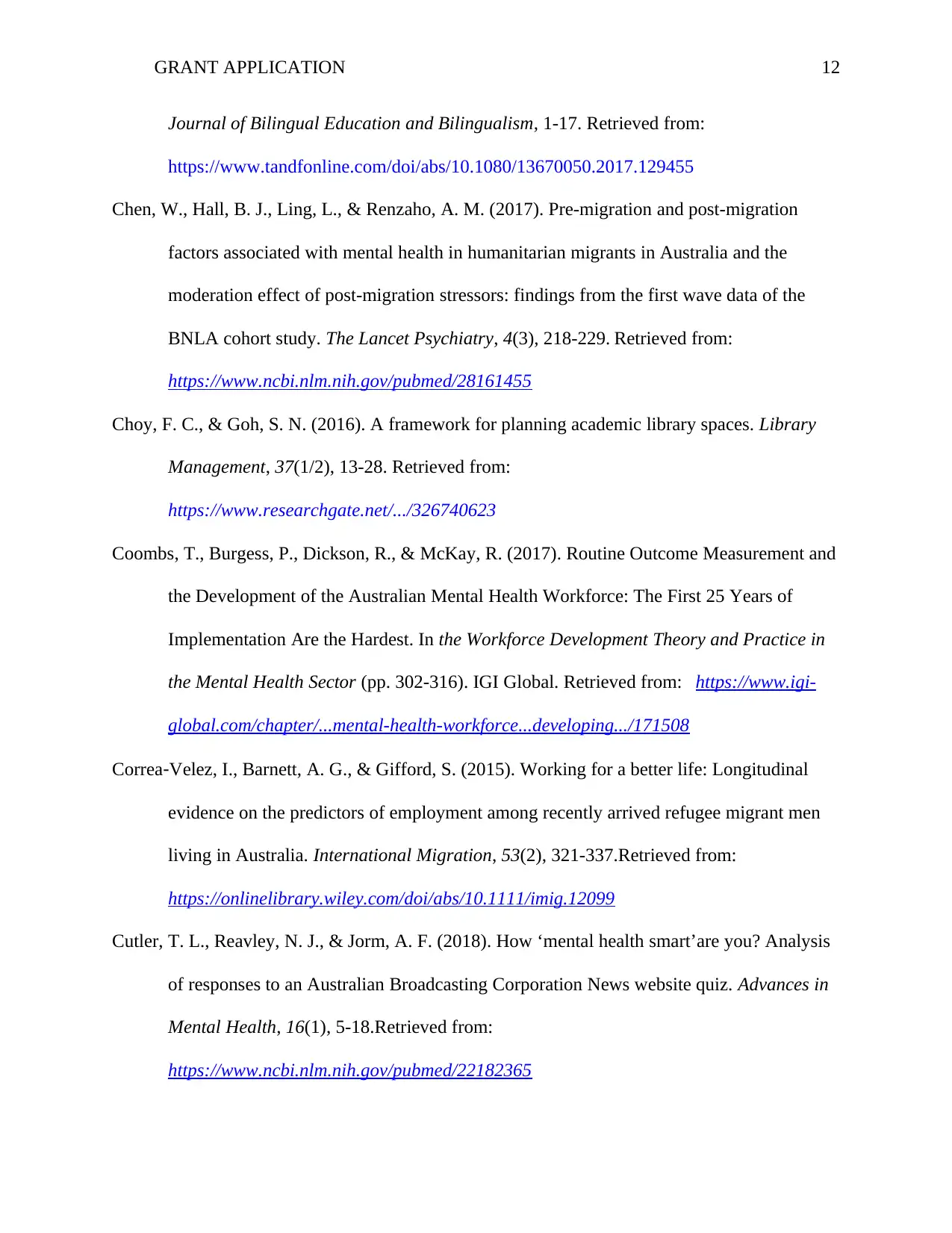
GRANT APPLICATION 12
Journal of Bilingual Education and Bilingualism, 1-17. Retrieved from:
https://www.tandfonline.com/doi/abs/10.1080/13670050.2017.129455
Chen, W., Hall, B. J., Ling, L., & Renzaho, A. M. (2017). Pre-migration and post-migration
factors associated with mental health in humanitarian migrants in Australia and the
moderation effect of post-migration stressors: findings from the first wave data of the
BNLA cohort study. The Lancet Psychiatry, 4(3), 218-229. Retrieved from:
https://www.ncbi.nlm.nih.gov/pubmed/28161455
Choy, F. C., & Goh, S. N. (2016). A framework for planning academic library spaces. Library
Management, 37(1/2), 13-28. Retrieved from:
https://www.researchgate.net/.../326740623
Coombs, T., Burgess, P., Dickson, R., & McKay, R. (2017). Routine Outcome Measurement and
the Development of the Australian Mental Health Workforce: The First 25 Years of
Implementation Are the Hardest. In the Workforce Development Theory and Practice in
the Mental Health Sector (pp. 302-316). IGI Global. Retrieved from: https://www.igi-
global.com/chapter/...mental-health-workforce...developing.../171508
Correa‐Velez, I., Barnett, A. G., & Gifford, S. (2015). Working for a better life: Longitudinal
evidence on the predictors of employment among recently arrived refugee migrant men
living in Australia. International Migration, 53(2), 321-337.Retrieved from:
https://onlinelibrary.wiley.com/doi/abs/10.1111/imig.12099
Cutler, T. L., Reavley, N. J., & Jorm, A. F. (2018). How ‘mental health smart’are you? Analysis
of responses to an Australian Broadcasting Corporation News website quiz. Advances in
Mental Health, 16(1), 5-18.Retrieved from:
https://www.ncbi.nlm.nih.gov/pubmed/22182365
Journal of Bilingual Education and Bilingualism, 1-17. Retrieved from:
https://www.tandfonline.com/doi/abs/10.1080/13670050.2017.129455
Chen, W., Hall, B. J., Ling, L., & Renzaho, A. M. (2017). Pre-migration and post-migration
factors associated with mental health in humanitarian migrants in Australia and the
moderation effect of post-migration stressors: findings from the first wave data of the
BNLA cohort study. The Lancet Psychiatry, 4(3), 218-229. Retrieved from:
https://www.ncbi.nlm.nih.gov/pubmed/28161455
Choy, F. C., & Goh, S. N. (2016). A framework for planning academic library spaces. Library
Management, 37(1/2), 13-28. Retrieved from:
https://www.researchgate.net/.../326740623
Coombs, T., Burgess, P., Dickson, R., & McKay, R. (2017). Routine Outcome Measurement and
the Development of the Australian Mental Health Workforce: The First 25 Years of
Implementation Are the Hardest. In the Workforce Development Theory and Practice in
the Mental Health Sector (pp. 302-316). IGI Global. Retrieved from: https://www.igi-
global.com/chapter/...mental-health-workforce...developing.../171508
Correa‐Velez, I., Barnett, A. G., & Gifford, S. (2015). Working for a better life: Longitudinal
evidence on the predictors of employment among recently arrived refugee migrant men
living in Australia. International Migration, 53(2), 321-337.Retrieved from:
https://onlinelibrary.wiley.com/doi/abs/10.1111/imig.12099
Cutler, T. L., Reavley, N. J., & Jorm, A. F. (2018). How ‘mental health smart’are you? Analysis
of responses to an Australian Broadcasting Corporation News website quiz. Advances in
Mental Health, 16(1), 5-18.Retrieved from:
https://www.ncbi.nlm.nih.gov/pubmed/22182365
⊘ This is a preview!⊘
Do you want full access?
Subscribe today to unlock all pages.

Trusted by 1+ million students worldwide
1 out of 14
Your All-in-One AI-Powered Toolkit for Academic Success.
+13062052269
info@desklib.com
Available 24*7 on WhatsApp / Email
![[object Object]](/_next/static/media/star-bottom.7253800d.svg)
Unlock your academic potential
Copyright © 2020–2025 A2Z Services. All Rights Reserved. Developed and managed by ZUCOL.

